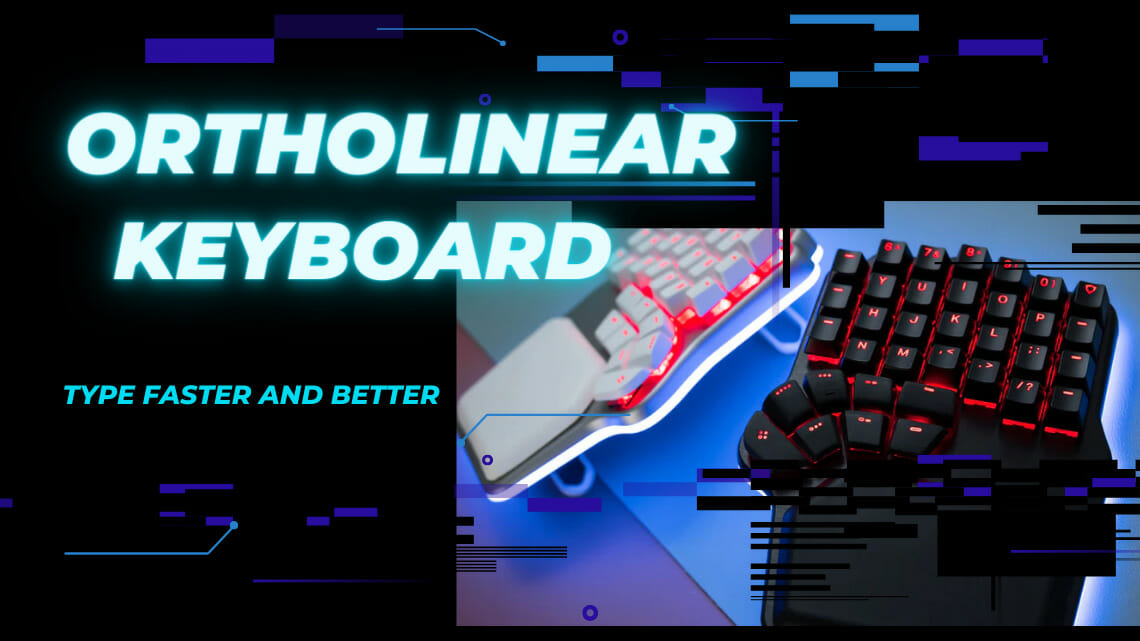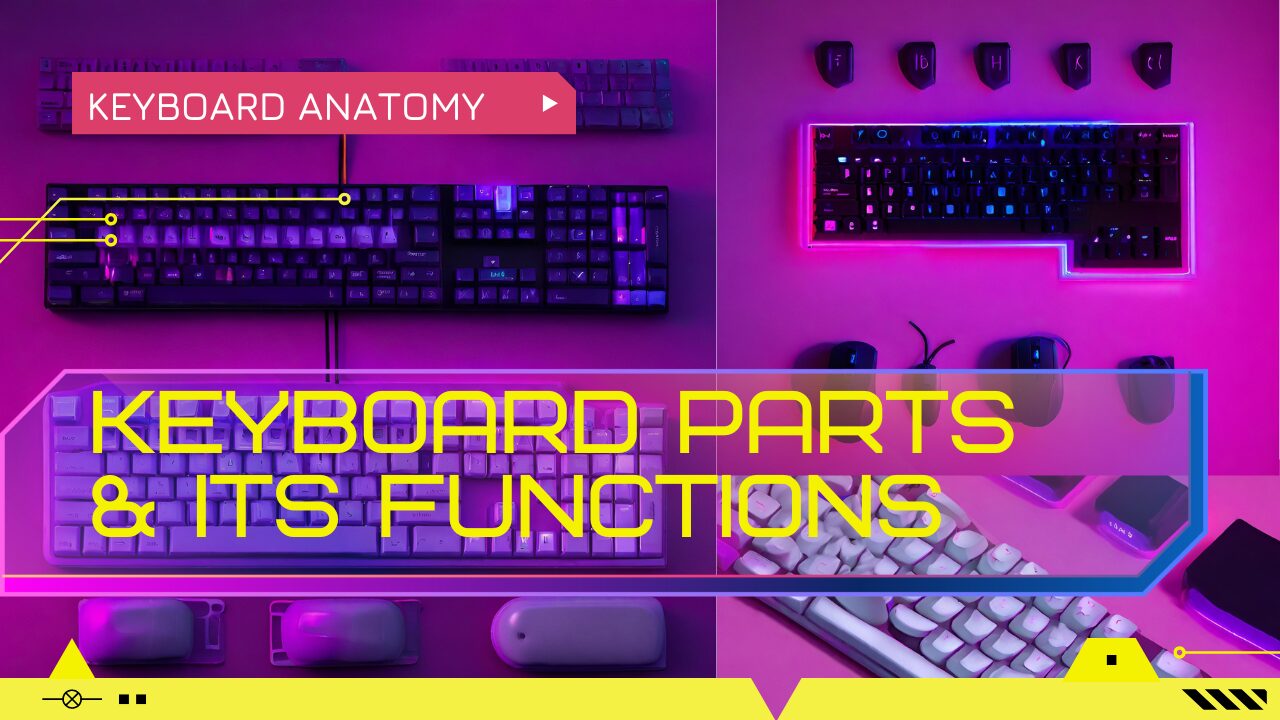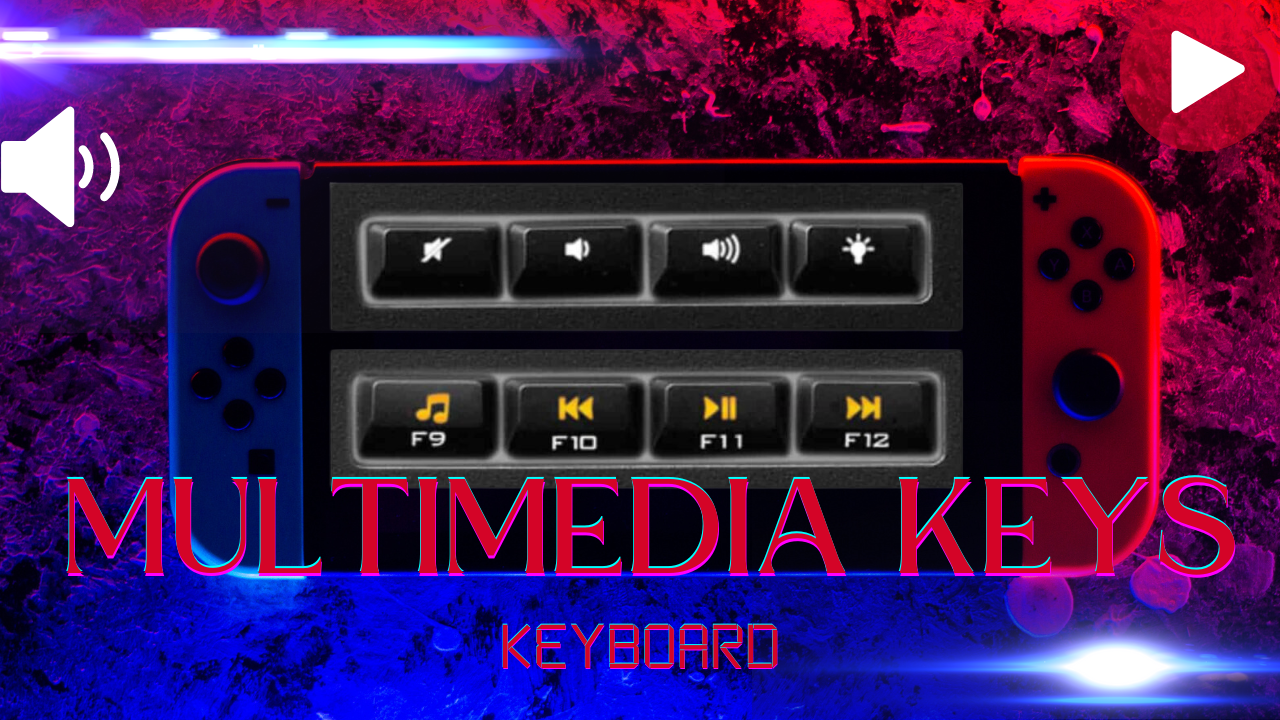
Do you ever feel like your fingers move everywhere when you type on a regular keyboard?
Well, there’s a new kind of keyboard for those looking for a different typing experience: the Ortholinear keyboard. It’s like a mini waffle iron, with all the keys lined up in straight lines (rows and columns). This differs from the traditional staggered keyboards where the keys are not lined up. Many people in the mechanical keyboard community like this design because it feels more comfortable and makes you type faster. If you want to try something new for your typing speed, try an ortholinear keyboard.
So, what are ortholinear keyboards? And why do people use them?
In this article, we will define ortholinear keyboards, discuss their history and evolution, and explain their key features, benefits, drawbacks, and top models in today’s market.
What is an Ortholinear Keyboard?
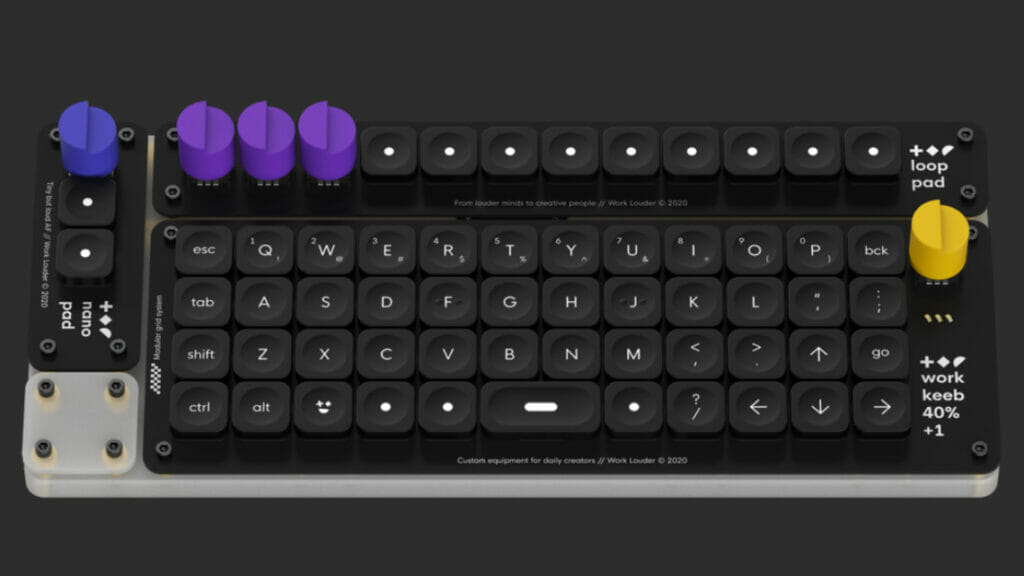
An ortholinear keyboard is a computer keyboard where the keys are arranged in straight rows and columns, forming a neat grid. Unlike the usual staggered layout, where keys are slightly offset, ortholinear keyboards have perfectly aligned keys.
The word “ortho-linear” comes from the Greek words “orthos,” meaning “straight,” and “linear,” meaning “arranged in a straight line.” So, an ortholinear keyboard is a functional keyboard with keys arranged in straight lines. This means you don’t have to struggle to find keys like “Enter” or “Backspace” because each key has its place.
History and Evolution of Ortholinear Keyboards

The first ortholinear keyboard was designed and built in the 1970s by David Dvorak, the inventor of the Dvorak keyboard layout. However, in the early 2010s, ortholinear keyboards began to gain popularity among the general public.
This was partly due to the rise of 3D printing, which made it easier and more affordable for people to build their ortholinear keyboards. Additionally, several new ortholinear keyboard manufacturers emerged, offering pre-built models for consumers.
Today, ortholinear keyboards are used by a wide variety of people, including programmers, writers, gamers, and hobbyists. They are also becoming increasingly popular in workplaces as businesses recognize the benefits of ergonomic keyboards.
Understanding the Benefits of Ortholinear Keyboards

Ortholinear keyboards offer several benefits that appeal to keyboard enthusiasts and those seeking a unique typing experience:
- Layout: The ortholinear layout aligns keys vertically and horizontally, resulting in a more uniform arrangement. Each key has a predictable position, which can lead to improved typing accuracy over time. Additionally, split ortholinear keyboards are designed for improved ergonomics by separating the keyboard halves for a more natural hand positioning.
- Ergonomics: Ortholinear layouts promote a more natural hand position. Many users find ortholinear keyboards more ergonomic. The straight rows and columns reduce finger movement and strain, potentially minimizing discomfort during extended typing sessions.
- Accuracy and Speed:
- Once users adapt to the grid-like layout, they often report improved typing accuracy. The consistent key placement reduces the chances of hitting adjacent keys accidentally.
- Ortholinear keyboards encourage touch typing, as each key has a predictable position. This can lead to faster typing speeds over time.
- Customization:
- Many ortholinear keyboards are programmable, allowing users to remap keys, create custom macros, and adjust layouts to their preferences.
- Enthusiasts can fine-tune their keyboards to match their workflow, gaming needs, or key combinations.
- Compact Size: Some ortholinear keyboards come in compact layouts (40% or 60%), saving desk space and making them portable for travel or limited workspaces.
- Unique Aesthetic:
- The grid keyboard arrangement stands out from traditional staggered keyboards, appealing to those who appreciate unconventional designs.
- Some users enjoy the minimalist look of ortholinear mechanical keyboards.
- Community and Culture: Ortholinear keyboards have an active community of enthusiasts sharing tips, building guides, and collaborating on firmware development. The community fosters creativity, leading to innovative layouts and keycap designs.
Whether you build your ortholinear keyboard or opt for a prebuilt version, these keyboards offer a refreshing alternative to the standard keyboard layout.
Ortholinear Keyboards vs. Staggered Keyboards: What’s the Difference?
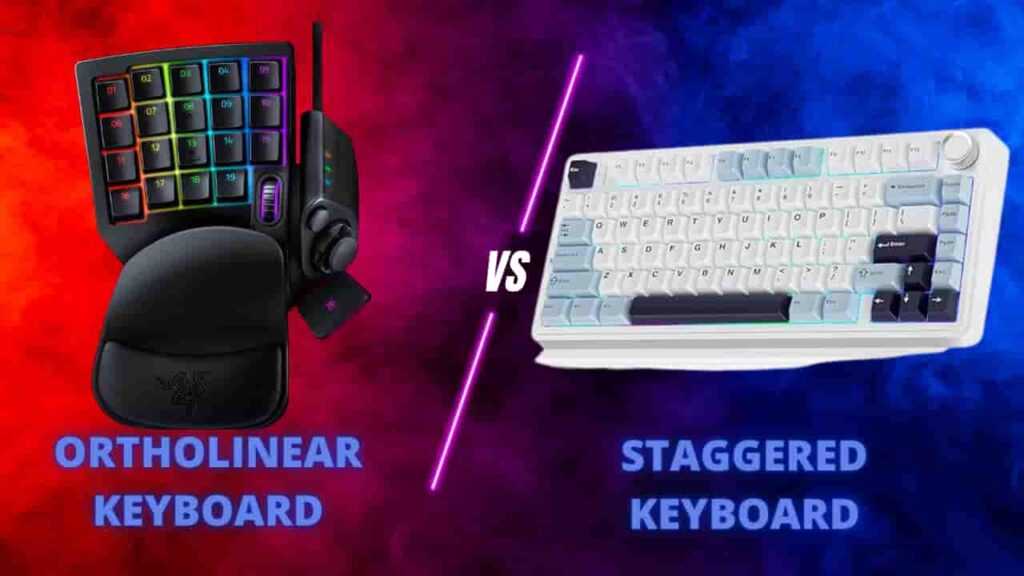
Now that we understand the benefits of ortholinear keyboards, let’s compare them to the traditional staggered keyboards we are accustomed to. Staggered keyboards have been the standard for decades, but they may not be the most efficient option.
The key difference lies in the arrangement of the keys. Staggered keyboards have been around for a long time. The keys are arranged so that each row is a bit higher than the previous one. This design was made to fit the mechanics of typewriters. But with modern technology, it might not be the best choice anymore.
Ortholinear keyboards, on the other hand, offer a more logical and efficient layout. The keys are aligned straight, so your fingers don’t have to move around as much. This makes typing faster and more accurate, and you don’t have to stretch your fingers as much.
In conclusion, ortholinear keyboards offer a more logical and efficient layout than staggered ones.
Pros and Cons of Ortholinear Keyboards
| Pros of Ortholinear Keyboards |
|---|
|
| Cons of Otholinear Keyboards |
|---|
|
Different Types of Ortholinear Keyboards
Ortholinear keyboards offer an alternative layout that can benefit ergonomic comfort and typing efficiency. Let’s explore the different types:
- Full-size ortholinear keyboards: For those who prefer a more traditional layout, full-size ortholinear keyboards are also available. These keyboards feature a standard 100% layout with a numeric keypad, function, and multimedia keys. This can be a good option for users who need a traditional keyboard’s functionality but want the ergonomic benefits of an ortholinear layout.
- Compact ortholinear keyboards: These have fewer keys than a traditional full-size keyboard. This makes them more portable and easier to use on a desk with limited space. However, they may require some function layers to access all the keys typically found on a full-size keyboard.
- Functional Keyboard (60% Layout): Functional keyboards, also known as 60%, are another popular choice among ortho linear keyboard enthusiasts. These keyboards feature a standard alphanumeric layout and additional function keys, balancing compactness and functionality. They are a good option for users comfortable using function layers to access less frequently used keys.
- Split Ergonomic Keyboard: Split keyboards are designed to improve ergonomics by allowing users to position the two halves of the keyboard at shoulder width. This design promotes a more natural hand and arm position, reducing strain on the wrists and fingers. Split mechanical keyboards can be found in both traditional staggered and ortholinear layouts.
Top Ortholinear Keyboards to Consider
A diverse range of ortholinear keyboards is available today, each with unique features and benefits. Here are some of the most popular models in the market.
1. OLKB Planck
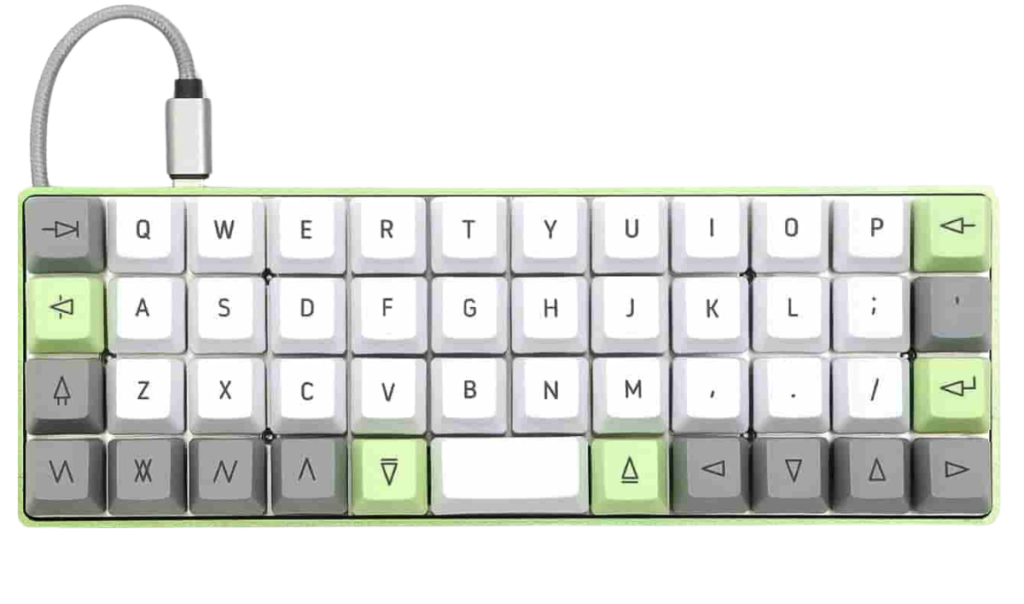
The OLKB Planck, designed by Jack Humbert, is a well-known ortholinear keyboard. It features a compact 40% layout with either 47 or 48 keys, depending on whether you prefer a slightly larger spacebar key. Assembling the Planck involves purchasing the PCB, plate, and case separately from the OLKB website.
The PCB is hot-swappable, eliminating the need for soldering. You can customize the keyboard’s appearance and colors. Being fully programmable with QMK firmware, the Planck allows you to tailor the key layout to your liking. The active community provides support and answers to build-related questions.
2. Planck EZ
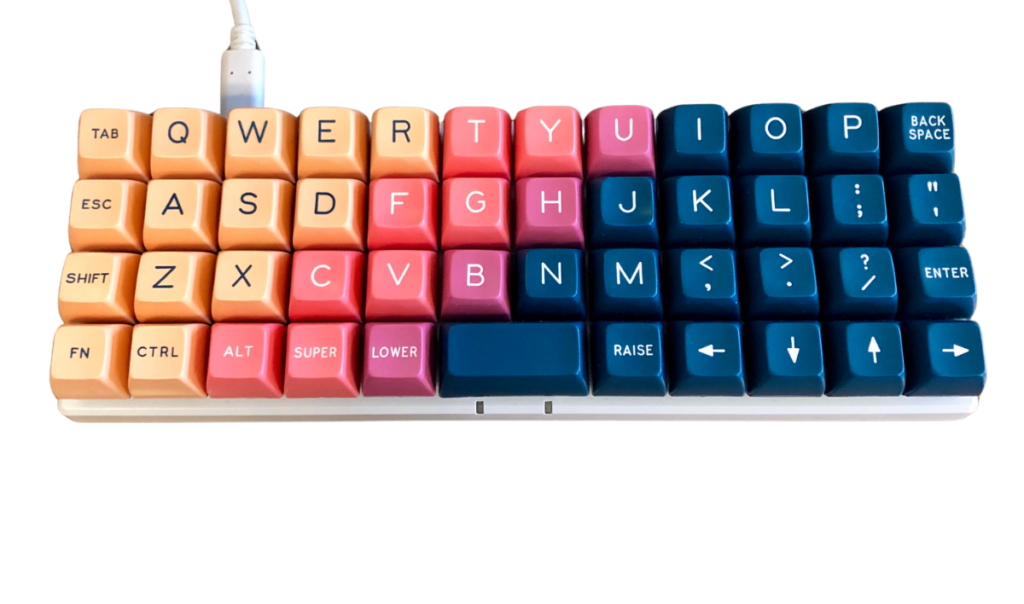
The Planck EZ builds upon the OLKB Planck framework but comes prebuilt and instantly accessible. You can order it directly from ErgoDox. The Planck EZ includes Oryx software, making it easy to customize key layouts, create dual-function keys, and control mouse functions. It also features fully programmable RGB lighting. You can choose from Cherry MX or Kailh switches.
3. Preonic
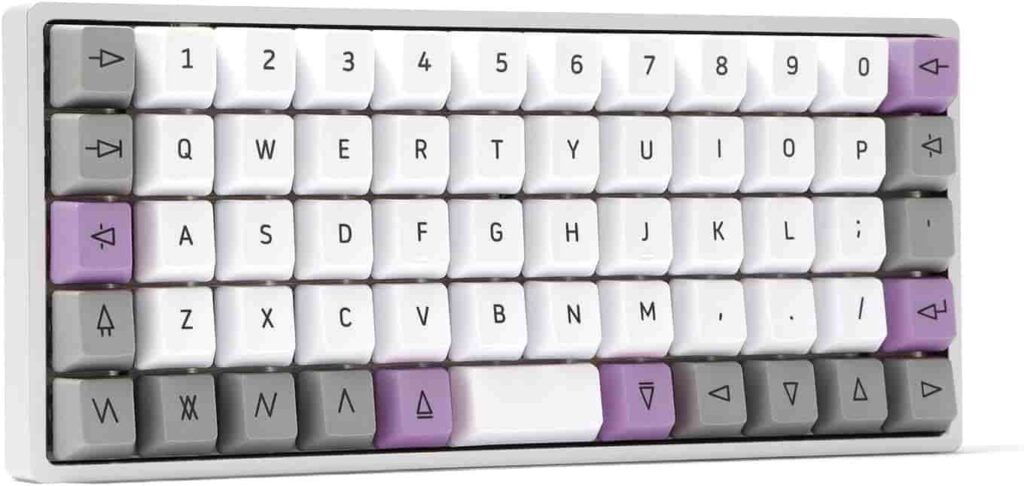
Another excellent ortholinear keyboard from OLKB, the Preonic offers a compact form with a 50% layout. It’s a step up from the Planck in terms of key count, providing more keys for additional functionality. Like the Planck, it’s fully programmable and encourages customization.
4. Moonlander
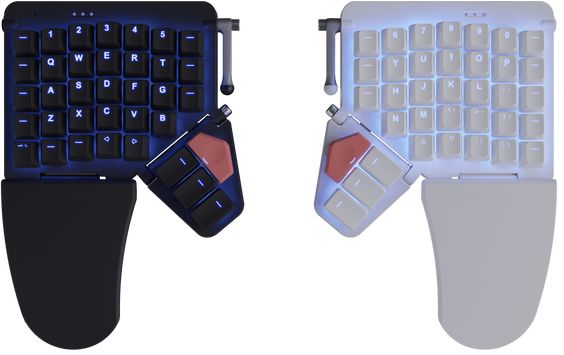
The Moonlander is a unique combination of an ortholinear layout with a split ergonomic design. It’s packed with features including adjustable typing angles, customizable thumb modules, and magnetic clips for portability. The Moonlander also comes with powerful software for customization and even includes typing training to help users adjust to the unique layout.
5. ErgoDox EZ
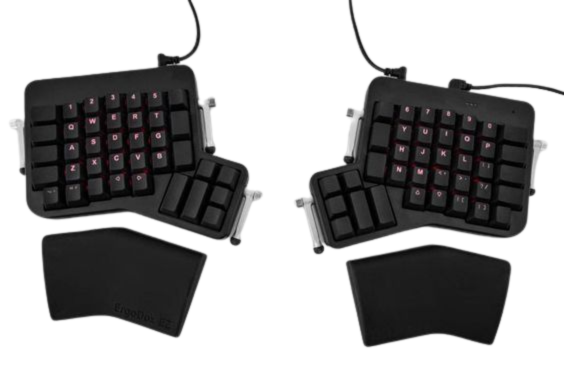
The ErgoDox EZ is an ortholinear split keyboard that comes pre-assembled and loaded with features. It offers a tilting system for adjustable typing angles, a range of switch options, and programmable RGB lighting. Like the Planck EZ, the ErgoDox EZ can be easily remapped using the Oryx software.
Choosing the Right Ortholinear Keyboard
Ortholinear keyboards are a great way to improve your typing comfort and efficiency. However, with so many different ortholinear keyboards on the market, knowing which one is right for you can take time and effort. This section will discuss some key factors when choosing an ortholinear keyboard.
When choosing an ortholinear keyboard, there are a few key factors to consider:
- Use Case: Identify your purpose – coding, writing, or gaming.
- Key Layout:
- Full-Size: Easy for beginners, including a numeric pad.
- Compact Designs (60% or 40%): For advanced users or limited space.
- Pre-Built vs. Custom Keyboards:
- Pre-Built: Convenient, but limited customization.
- Custom: Personalized experience, choose ortholinear keycaps and switches.
- Key Switches: Ortholinear keyboards use various key switches. Each type of switch has its unique feel and sound. Some popular key switches include Cherry MX Blues, Browns, and Reds.
- Backlighting and Additional Features: Some ortholinear keyboards come with RGB backlighting, which can help type in low-light conditions. Other keyboards, such as a built-in trackpad or OLED display, may have different features. When choosing a keyboard, you must consider which elements are essential.
- Price Range: Ortholinear keyboards range from around $100 to $500, from affordable options to high-quality custom builds.
Adjusting to Ortholinear Keyboards
Switching to an ortholinear keyboard can be a challenge at first. Still, it can be a rewarding experience with a bit of practice. Here are a few tips to help you adjust:
- Start slowly. Don’t try to switch to an ortholinear keyboard cold turkey. Start using it for short periods, such as 30 minutes to an hour each day. As you get more comfortable, you can gradually increase your use time.
- Be patient. It takes time to learn a new keyboard layout. Keep going even if you make mistakes at first. Just keep practicing, and you will eventually get the hang of it.
- Use a typing tutor. There are several typing tutors available online and in software form. A typing tutor can help you to learn the new keyboard layout and improve your typing speed and accuracy.
- Take breaks. Take a break if you feel pain or discomfort in your hands or wrists. Ortholinear keyboards are designed to be ergonomic, but taking breaks is essential to avoid overuse injuries.
Common Typing Challenges and Solutions
One of the biggest challenges of switching to an ortholinear keyboard is reaching specific keys, especially if you have small hands. To overcome this challenge, try using different finger combinations or moving your hands around on the keyboard.
For example, try using your right index finger to hit the “P” key instead of your middle finger. You can also remap specific keys to more convenient locations. For example, you could remap the “Shift” key to the “Caps Lock” key or the “Ctrl” key to the “Tab” key.
Another common challenge is hitting the wrong keys. This is simply because the critical placement is different from a traditional keyboard. To reduce the number of mistakes you make, try to focus on the order of the keys and be careful not to rush your typing. You can also try using a typing tutor to help you learn the new layout.
Finally, it’s normal to experience a decrease in typing speed when you first switch to an ortholinear keyboard. This is because you’re learning a new keyboard layout, and your fingers are unused to the new key placement. Your typing speed will eventually return to normal and may improve with practice.
Conclusion:
Ortholinear keyboards can offer several benefits, including improved typing comfort, efficiency, and ergonomics. However, with so many different ortholinear keyboards on the market, knowing which one is right for you can take time and effort.
When choosing an ortholinear keyboard, consider the layout options, key switches, backlighting, and additional features. Start with a smaller keyboard with a more compact layout if you are new to ortholinear keyboards. Experiment and find one that is comfortable for you and meets your needs.
I hope this blog post has been helpful.
What is an ortholinear keyboard layout?
An ortholinear keyboard layout is a keyboard layout where the keys are arranged in a grid, with all the rows and columns aligned. This contrasts traditional staggered keyboard layouts, where the keys are offset.
Why do people use ortholinear keyboards?
People use ortholinear keyboards for a variety of reasons, including:
- Improved ergonomics: Ortholinear keyboards can help to improve typing ergonomics by reducing the amount of wrist and finger movement required to type.
- Increased typing speed and accuracy: Some people can type faster and more accurately on an ortholinear keyboard than on a traditional staggered keyboard.
- More comfortable typing experience: Some people find ortholinear keyboards more comfortable than traditional staggered keyboards.
What is the meaning of Ortholinear?
The word “ortholinear” is a combination of the words “ortho” (meaning “straight”) and “linear” (meaning “arranged in a straight line”). Therefore, an ortholinear keyboard has the keys arranged in a straight line.
Are ortholinear keyboards better?
There’s no simple yes or no. Some people love them for comfort and speed, while others prefer the standard layout. It depends on your typing style and what feels best for you.
What are ortho keys?
Ortho keys are simply individual keys on an ortholinear keyboard. They are all the same size and rectangular.
Are ortho keycaps different?
Not necessarily! Some ortholinear keyboards might use keycaps specifically designed for their layout, but many keyboards can use regular keycaps as long as they fit the switch type.
What are the benefits of using an ortholinear keyboard?
Benefits of using an ortholinear keyboard:
- Improved ergonomics
- Increased typing speed and accuracy
- More comfortable typing experience
What are the different types of ortholinear keyboards?
There are a variety of different types of ortholinear keyboards available, including:
- Full-size ortholinear keyboards: These have the same number of keys as a traditional full-size keyboard.
- Compact ortholinear keyboards: These have fewer keys than a traditional full-size keyboard. This makes them more portable and easier to use on a desk with limited space.
- Split ortholinear keyboards: These are split into two halves, one for each hand. This can help to improve ergonomics and reduce fatigue.
How do I choose the right ortholinear keyboard for me?
When choosing an ortholinear keyboard, there are a few things to consider:
- Size: Consider how much space you have on your desk and how portable you need the keyboard.
- Layout: There are a variety of different ortholinear keyboard layouts available. Choose a layout that is comfortable for you to type on.
- Features: Some ortholinear keyboards have additional features, such as backlighting, programmable keys, and a built-in trackpad. Consider which features are important to you.
- Price: Ortholinear keyboards can range from around $100 to $500. Set a budget before you start shopping.
What are the best ortholinear keyboards?
The best ortholinear keyboard for you depends on your individual needs and preferences. However, some popular ortholinear keyboards include:
- Planck: A compact ortholinear keyboard with 40 keys.
- Preonic: A 60% ortholinear keyboard with 64 keys.
- Ergodox EZ: A split ortholinear keyboard with 64 keys.
How do I learn to type on an ortholinear keyboard?
If you are new to ortholinear keyboards, there are a few things you can do to learn to type on one:
- Start with a smaller keyboard. A smaller keyboard will have fewer keys to learn and be easier to adapt to.
- Use a typing tutor. There are several typing tutors available online and in software form. These tutors can help you learn the new keyboard layout and improve your typing speed and accuracy.
- Be patient. It takes time to learn to type on a new keyboard layout. Don’t get discouraged if you don’t see results immediately.
